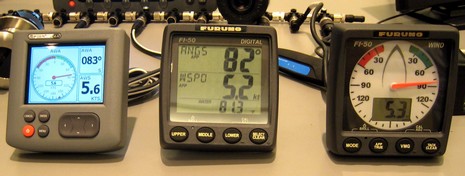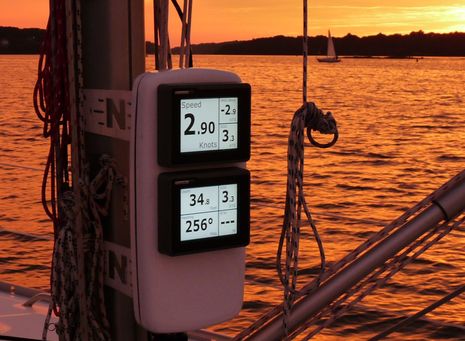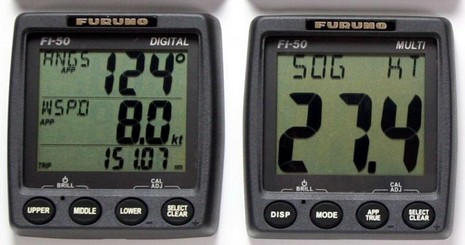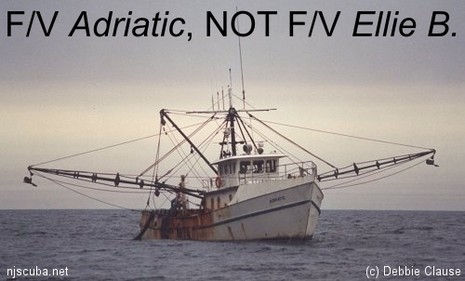Furuno FI-50 instruments, & more N2K

It’s a crappy picture, but this scene, bigger here, does give some sense of what Raymarine’s new ST70 instruments look like next to the brand new Furuno FI-50 series mentioned yesterday. The ST70’s look almost as good as the PR photography, but you can see that the screen is a little smaller than Furuno’s, which will also cost less (“about the price of ST 60s”, said the Furuno guys). The FI-50s aren’t at all graphic, but I thought the wind gauge with its “Formula 1 style” white face was very readable from a distance. There are three more FI-50 displays in that same style—close hauled wind, heading, and rudder angle. There’s also another digital display with one large data field, and the backlighting on all is automated and they draw little power as those are OLED screens. I fooled with the button controls and found the instruments easy to work, and that there are lots of data types supported.
The picture, by the way, was taken at the Airmar booth and the NMEA 2000 wind data is coming from a new Weather Station model that outputs both N2K and 0183, has improved sensors, and will ship “this winter”. And the network could have included a new series of Simrad N2K instruments that look quite interesting. There’s much to learn about all these new instruments, but there’s little doubt that Furuno has done well on the N2K cabling front. Each of the FI-50 instruments has both male and female metal Device Net style connectors on the back, so they can be either tee’d from a backbone or daisy chained. Each also includes a switchable terminator so it can be set as the end of a backbone. Finally, seen below, Furuno has come up with an N2K cable box that can act as a backbone junction and 6 tees. This will be useful to an installer with tricky wire runs, a tight budget, or a burning need to strip wire. Oh, and the two wind instruments have a third connector for a new Furuno analog wind sensor whose data goes out as standard N2K PGNs, and the FI-50 brochure suggests that that Furuno will also be offering an N2K Weather Station and Depth/Speed/Temp triducer (no doubt Airmar’s). All good news, but possibly minor compared to NavNet 3D, debuting next Wed. night. By the way, Furuno is showing a bit more 3D leg here, and I like it.














Ben,
1) How is the glare in direct sunlight with these displays ?
2) How good is the viewing angle ?
Dan
Assuming the wind data source is the same for all the displays, is there a reason that the values shown on each are different?
Sorry, Dan, can’t answer those questions yet, but will get out on a boat with ST 70s next Wed. Nat, I think the difference in the data is just network and device timing.
I have an ST60+ graphic that is very hard to read due to glare, and even when no glare, you cannot read at wide angles (even though it is advertised that way) although you can read the other ST60+ displays at pretty wide angles. Raymarine tech support is in denial that this is a problem with the ST60+ graphic, been waiting on Steve Crane to resolve, maybe the ST70 is the answer.
Where did Furuno get “ANGS”? A new acronym generator? How about AWA? Gotta go with Raymarine on the acronyms.
That’s a lot of backlighting on the ST-70 display, no issue on your motoryacht, but I’m curious how the power consumption compares to the FI-50’s for a sailboat.
The FI-50 digital display looks like the old ST-40 “tri” display, very dated.
It seems to me that the “strip and insert wires” defeats the reliability that N2K connectors provide. That product is a step backwards, not forward.
How about an N2K wireless gateway and some solar powered displays. TackTick style but N2K compatible? That would be a big step forward. If they really worked it would be an installers dream.
I haven’t had any problems viewing the ST60+ Graphic displays at wide angles, unless of course you are wearing polarized sun glasses, then you have to tilt your head quite often. I can view ours across the cockpit from the other wheel with no problem.
ibsailn,
Really … maybe my unit is defective?
I find that as you start looking off center the contrast of the numbers against the background rapidly diminishes after 25 degrees to ether side of center, to the point the numbers dissapear around 35 degrees …. compared to the ST60 tri or wind instrument wind speed lcd that is viewable well past 80 degrees off center.
I have the contrast on my graphic, which isn’t really that good to begin with, pumped up to the point where any additional increases, cause the background to darken.
Ray’s tech support tells me that in fact the viewing angle is much less because a different type of display element is used in the ST graphic. My graphic is installed at the head of the companionway to help crew optimize their sail trim. I have a cockpit that’s almost as wide as it is long, so viewing angles anything less than 90 degrees off center is hard to see from either of the winches without leaning into the cockpit, and 35 degrees is just impossible to see even leaning in. I have a $30 mini weather station in my cockpit with nifty graphics on it that is viewable from 120 degrees off center, and don’t understand why ray couldn’t have spent an extra dollar or two on a more expensive display element on their ST’s.
… or maybe mines defective. What would you describe your viewing angle to be ibsailn ?
I am sailing the boat down to Newport this weekend and will try to remember to measure the viewing angles. If I don’t remember, the boat will be in town and I can do it anytime. I will post here after the weekend.
The network featured is not exactly large. So is it a common occurence with NMEA2K to see delays and differences in data arriving at different units? If this were a countdown sequence for a race start for example, that would not be very helpful!
Sailed the boat down this weekend, and broke out the protractor to look at viewing angles. Well, it appears the ST60+ Graphic is very sensitive to the combination of horizontal and vertical viewing angle. When viewed perpendicular to the face vertically, the side to side viewing angle measured at about +/- 40 degrees (compared to +/- 65 or more for the old ST60 multi). The vertical viewing angles are similar between the two, going up to about 65 or more degrees. Interestingly, if you are above about 25 degrees above the display vertically, the horizontal viewing angle increases dramatically, and approaches that of the older ST60 multi. This is why I can view the dash mounted graphic from across the cockpit (it is much lower, so I am looking down at it as well as across). My guess is that the problem with B393capt’s install is that he is generally in line vertically, and that is why your horizontal viewing angles are so poor. There is also about 10 degrees difference between daylight and night viewing. Hope this helps.
ibsailn, Thankyou !
Yes, my install is in-line vertically.
Yes, it is very very helpful to have your observation.
Thank you again!
Dan
Ben,
1) How is the glare in direct sunlight with these displays ?
2) How good is the viewing angle ?
3) Power requirements vs. ST60+ ?
4) Is the software field upgradable, say from a small memory chip as the E-series is ?
5) In regards to N2K, will it be entirely compatible with the Maretron weather station and compass, or, do you still need to buy a Maretron N2k display to get full functionality ?
Dan